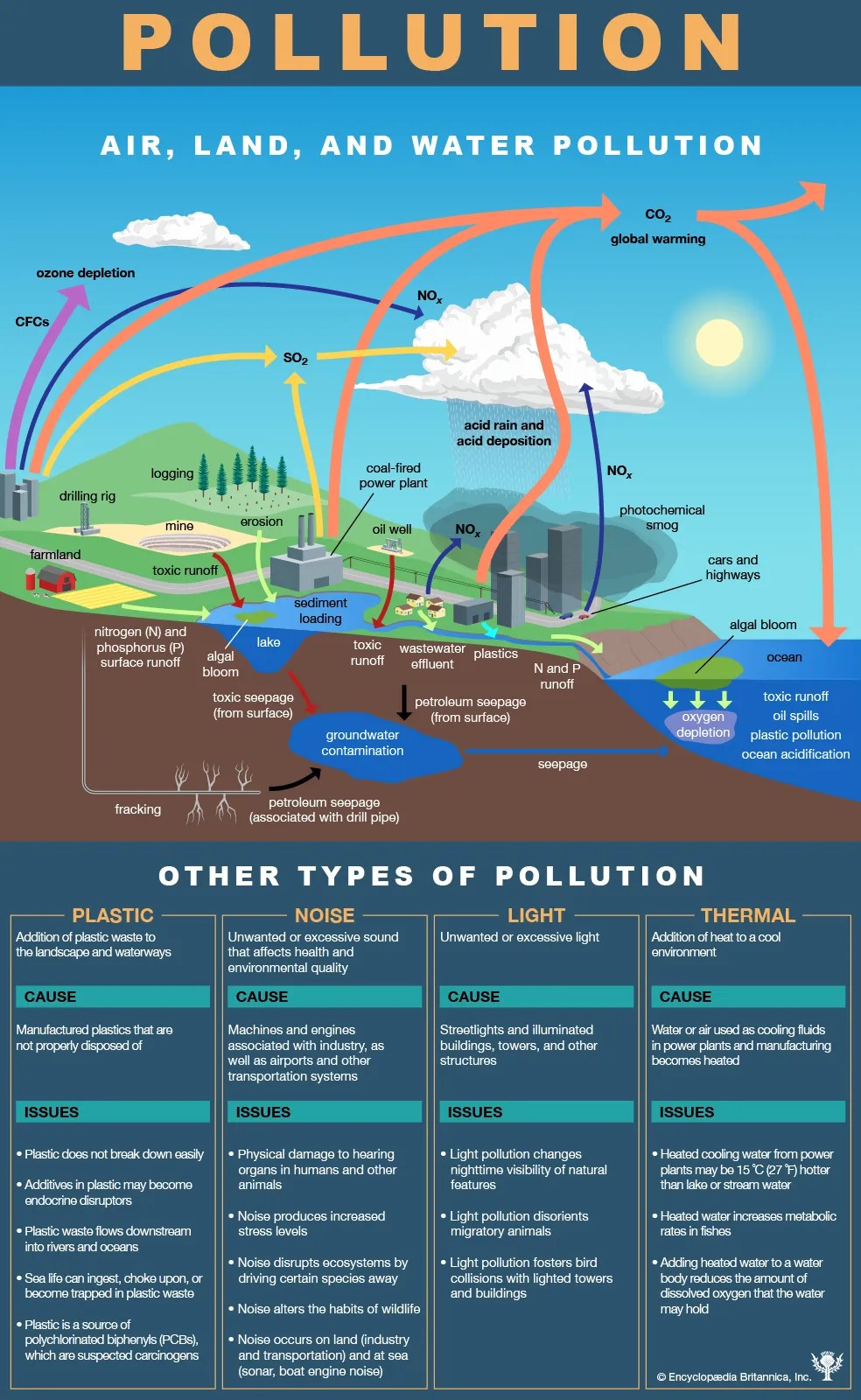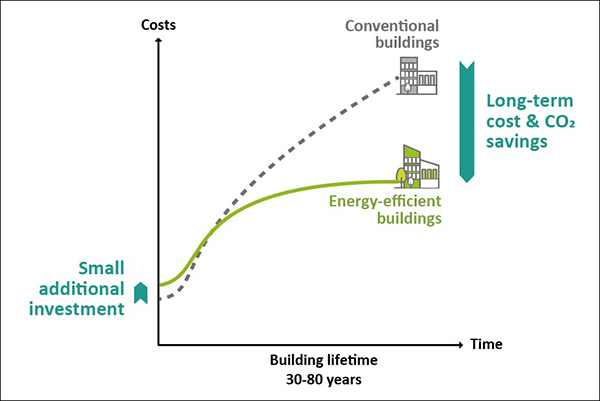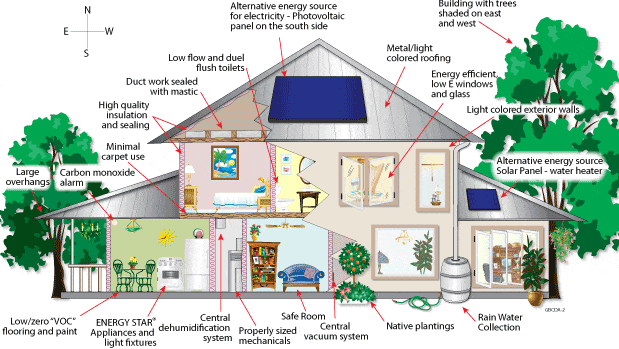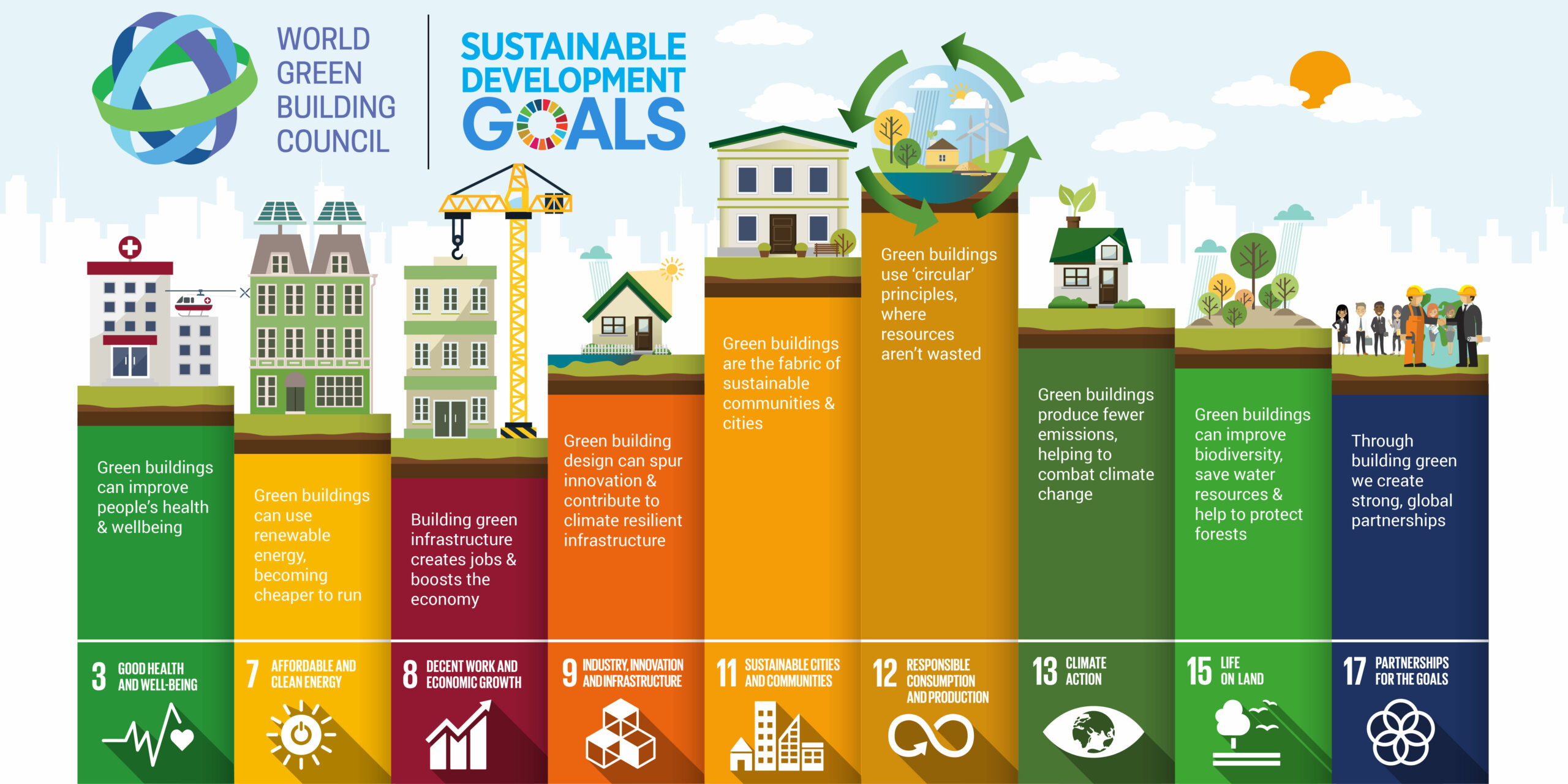Introduction to Greening the Construction Trades
A Short Guide by ECO Canada and CICan
This document provides an introduction to Greening the Construction Trades. It briefly describes the sources of Greenhouse Gas (GHG) emissions from buildings and construction, how emissions can be reduced, as well as regulations and policies supporting emissions reductions. Climate change is a complex problem, and because solutions require evolving past conventional building approaches, tradespeople involved in the construction or retrofitting of a building are encouraged to collaborate with the other tradespeople working on the project as well as conduct research into the best options when it comes to materials, energy, and the building design and functionality as a whole system. This summary will provide only a brief introduction and further learning and understanding of sustainable approaches to the building trade is encouraged.
Basics of Environmental Management
Basics of Environmental Management
Environmental Management is the approach and methodology by which we minimize and mitigate impacts of our economy and our physical environment that supports economic development. Traditionally, Environmental Management has monitored and regulated the following types of pollution and impacts:
- Air pollution: the presence of solid, liquid particles and gases in the atmosphere which may be harmful for humans, planet which includes buildings. Eg., Acid rain is a product of sulfur dioxide and nitrogen dioxide released from industrial practices causes damage to plants, buildings, soil, and animals.
- Water pollution: the contamination of water which makes it harmful to aquatic life, disturbing the natural ecosystems, and can make water no longer potable or usable by non-aquatic wildlife or for household purposes.
- Solid waste management (SWM): discarded materials that have served their purposes and can no longer be used. SWM refers to collecting, treating, and disposing of such materials.
- Hazardous waste: includes waste that is harmful to the environment if not treated and disposed of properly. Eg. paints and solvents, household cleaners etc.
(Source: Definitions sourced from www.britannica.com)
Additional forms of pollution and impacts have seen been addressed through Environmental Management as shown in the graphic:
(Odour pollution was not included but is still considered a type of pollution that can be emitted by different types of infrastructure, especially manufacturing or processing plants.)
Environmental and Energy Management in the Construction Sector
The Construction Sector is responsible for a significant portion of overall pollution and environmental impacts. This is just as true when it comes to climate change and greenhouse gas (GHG) emissions. It’s important to understand the source of pollution and GHG emissions so that we can begin to address it, reduce it, and find alternative approaches and materials in order to mitigate emissions and pollutants.
- The building sector is the third-largest source of GHG emissions in Canada.
- 13% of Canada’s GHG emissions are from the buildings sector; 18% if we include electricity-related emissions.
- Over 78% of building emissions come from space and water heating equipment. (https://natural-resources.canada.ca/)
How Do Buildings and Other Trades Contribute to Climate Change ?
The life cycle of a building could be broadly classified into 3 stages – Construction phase, operational phase and demolition phase. GHG emissions would be generated in all the three phases leading to climate change.
Another way to look at them is:
- Embodied Carbon: refers to the greenhouse gas (GHG) emissions, measured in carbon dioxide equivalents (CO₂e), associated with materials and processes that go to the construction, repair, and demolition processes throughout the whole lifecycle of a building (including the transportation of materials). Buildings generate 39% of annual global GHG emissions, with 28% coming from operations of buildings and 11% coming from building materials and construction processes (i.e., embodied carbon).
- Operational Carbon: refers to the carbon emissions associated with the day-to-day use of a building or product, including energy consumption for heating, cooling, lighting, and other activities. Operational carbon emissions are sometimes referred to as “in-use” emissions, as they are released during the period of time when the building or product is in operation.
(Source: Definitions sourced from www.gresb.com)
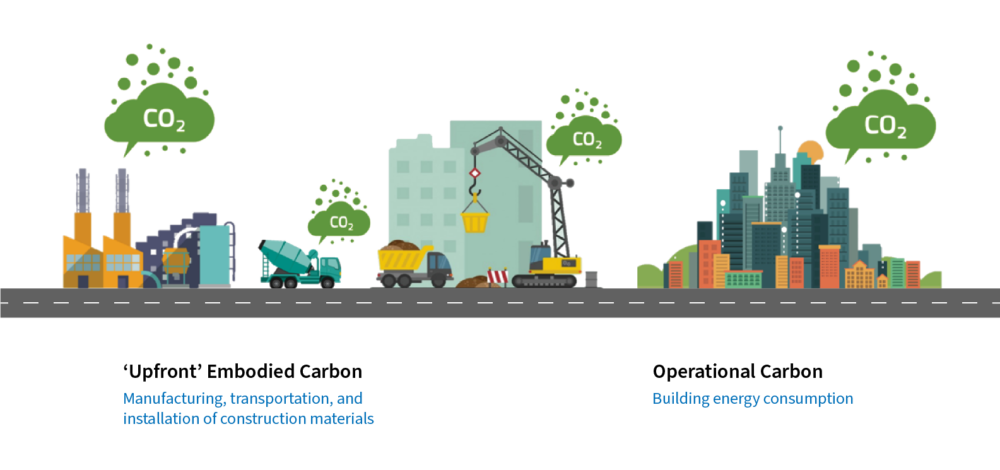
If we were to reduce GHGs in either our embodied or operational carbon it would have to be:
- Embodied Carbon: Using climate-friendly materials, using less gas-powered tools and vehicles and equipment and more those that require electricity to run them. Using low VOC paints, green steel, green cement, recycled materials such as wood, metals, insulation materials.
- Operational Carbon: The sustainable building design would be highly energy efficient leading to low operational emissions and costs. E.g., orientation of the building, usage of natural lighting etc.
But in order to plan properly, it’s best to integrate a Life Cycle Approach in building design, in order to consider all possible GHGs including those from waste. Integrating a Life Cycle Approach means taking a holistic perspective that considers the entire life cycle of a product, process, or system, and analyzing environmental, economic, and social impacts from cradle to grave—from raw material extraction to production, usage, and eventual disposal.
Key Principles of Life Cycle Approach
-
-
- Prevention: The best way to manage waste is to prevent it in the first place. By designing products for durability, repairability, and reuse, we reduce the need for disposal.
- Reuse and Recycling: Extending the life of products through reuse and recycling minimizes waste generation and conserves resources.
- Energy Recovery: When recycling is not feasible, energy recovery (such as incineration with energy capture) can be an alternative to landfilling.
- Landfilling: Landfills should be the last resort, reserved for materials that cannot be recycled or recovered.
-
A Life Cycle Approach is integral to the Circular Economy – meaning materials are reused, remanufactured, or recycled rather than discarded and therefore they move through a circular economy rather than just entering the economic system for a single-purpose use.
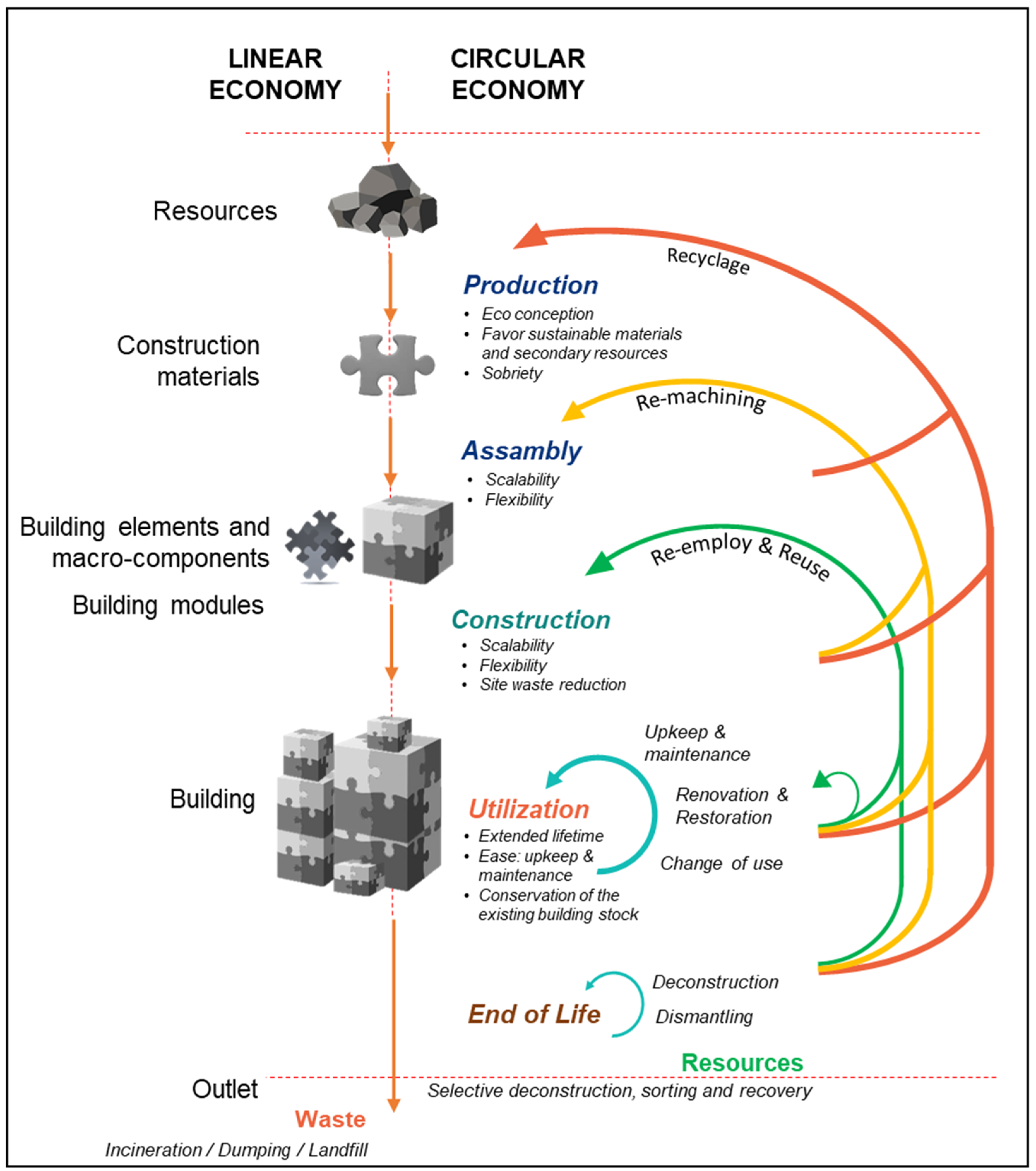
Achieving a life cycle approach requires collaboration among stakeholders, policy changes, and public awareness. But with Extended Producer Responsibility (EPR) programs, manufacturers are held accountable for managing their products throughout their life cycle, encouraging waste reduction.
(Sources:
https://link.springer.com/referenceworkentry/10.1007/978-981-16-4230-2_87
https://link.springer.com/article/10.1007/s11367-009-0111-7
https://link.springer.com/article/10.1007/s10163-019-00968-5
https://link.springer.com/article/10.1007/s10098-012-0481-6
https://www.unep.org/resources/policy-and-strategy/lifecycle-approaches-waste)
There are many different types of certifications and recognitions for buildings that consider a Life Cycle Approach and are climate-friendly.
Some certifications and ratings analyze and certify the embodied and operational emissions of the buildings (e.g. LEED, Green Globes, or BOMA Best).



Some certification focuses specifically on aspects of the building operation systems and appliances (Energy STAR)

The Living Building Challenge Certification focuses on the overall sustainability of a building including its carbon neutrality, impact on water, communities, waste, and more.
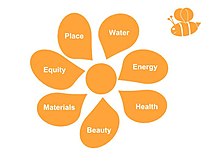
The Canada Green Building Council (CaGBC) has more information regarding some certification options.
Canada’s Commitments and Targets
When it comes to reducing our carbon emissions, general pollutants, and overall impacts on the environment during building, we must consider our commitments and targets.
-
- Canada has made a commitment to mitigating climate change with an ambitious goal of Net Zero. Canada is implementing this commitment in intervals by reducing our nation’s total GHG emissions to 45% below 2005 levels by 2030 and to reaching net-zero emissions by 2050.
- The Canada Green Building Strategy – The goal of the Canada Green Buildings Strategy is a net-zero emissions and climate-resilient buildings sector by 2050, with an interim goal of 37% emissions reduction from 2005 levels by 2030.
Canada will reach these targets with a mix of new construction and refurbishing/ renovating old stock.
Sources of Emissions in Construction and Buildings
The impact of each trade must consider the emissions from all materials used and how they are used. That includes construction energies, material selections, procurement and life cycle assessments with the aim of emission reductions.
How does your trade produce embodied carbon and operational carbon?
Main Sources of GHG Emissions According to Each Trade:
| Trade | Embodied Carbon | Operational Carbon | Main Emissions associated with Operational Carbon |
| HVAC | ducting materials, systems materials, including mining, processing, and transportation | Heating and Cooling | Refrigerants made of different types of Hydrofluorcarbons that have high Global Warming Potential (GWP). |
| Electrical | metals, silicon, and other mined resources including the processing and transportation | Use of appliances, grid electricity | Coal, natural gas, incinerators, and other fossil fuel sources for creating electricity – mainly sources of Carbon Dioxide, Methane, Nitrous Oxide |
| Carpentry | Harvesting of materials, transportation, production, processing, loss of carbon sinks from forests harvested | Overall building operations such as heat | Firewood, coal, natural gas, oil, propane and other heating sources to keep building warm result in Carbon Dioxide, Methane, nitrous oxide. |
| Landscaping | Equipment and material used for landscape – including loss of carbon sinks from peat harvested | On-going lawn maintenance | Pesticides, fertilizers, mowers, blowers, which produce Nitrous Oxide, Methane, Sulfuryl fluoride, Carbon Dioxide, Ozone |
When considering the construction trades, we must acknowledge that construction material comes with a certain amount of embodied emissions associated with its manufacturing. To reduce emissions, alternative and green building materials with low associated emissions, such as materials made from recycled content instead of virgin materials, could be selected. Procurement and transportation of materials could be through rail, ship etc. and could be procured from nearby to reduce the emissions from transportation. In the life-cycle of the building, we must consider that after demolition, the materials could be reused and recycled eg. doors, window frames, wiring, etc.
The Value of Sustainable Practices in the Building Trades
Sustainability means meeting our own needs without compromising the ability of future generations to meet their own needs. This refers to the usage of resources efficiently without over exploitation.
When it comes to the four trades covered in this OER, how can we apply principles of sustainability?
- HVAC: HVAC systems that integrate sustainability principles can be applied through the careful selection of refrigerants with lower Global Warming Potential (GWP). Opting for refrigerants with reduced GWP mitigates emissions and minimizes environmental damage, aligning with sustainability objectives. Additionally, implementing energy-efficient designs and technologies such as variable refrigerant flow (VRF) systems and heat recovery ventilation further enhances the sustainability of HVAC operations.
- Electrical: In the Electrical trade, embracing smart energy homes represents a sustainable approach by enabling real-time monitoring and management of energy consumption. This involves the integration of energy-efficient appliances, automatic on/off controls, occupancy sensors, and motion sensors to optimize energy usage and minimize wastage. Furthermore, the adoption of renewable energy sources such as solar panels coupled with energy storage solutions contributes to reducing reliance on fossil fuels and decreasing carbon emissions.
- Carpentry: Carpentry practices can be made more sustainable through the selection of energy-efficient equipment and tools, reducing energy consumption during carpentry operations. Additionally, prioritizing certified wood from sustainably managed forests not only promotes responsible forestry practices but also contributes to carbon sequestration. Certified wood products can serve as carbon offsets through biological sequestration, helping to mitigate the carbon footprint associated with construction activities.
- Landscape: In landscaping, sustainability principles are demonstrated by selecting native plant species and vegetation with high carbon sequestration capabilities. Native species require less water and maintenance, reducing the need for irrigation and chemical inputs while enhancing biodiversity. Moreover, strategic landscape design can contribute to passive cooling and heating of buildings, reducing energy consumption for HVAC systems. Incorporating energy-efficient or human-powered equipment such as electric mowers and trimmers or rakes instead of blowers further minimizes emissions associated with landscape maintenance operations.
Challenges and Opportunities
Challenges in up-front costs / initial investment:
In looking at the key challenges, including cost and availability/adoption of new technologies, we can see that the pace of the awareness and implementation of green practices directly correlates with the reduction of costs of sustainable and green materials over time. By calculating the cost benefit analysis on a long-term basis, we can see that green buildings would cost less compared to conventional buildings to build and to operate.
Challenges in new construction vs. retrofits
New construction could start with sustainable design approaches which lower the cost and emissions, whereas existing buildings could look at retrofits such as efficient lightings, motion sensors, occupancy sensors, procurement of green materials in case of renovation. The main challenge would be procurement of green building materials and their transportation. These could be addressed through planning and research/comparison between the materials.
Opportunity in collaboration and design
It’s important to collaborate with other trades teams working on the build to find / create key opportunities related to cost savings in long term, meeting climate change goals, etc. Especially when it comes to mitigation strategies, the following steps should be considered for a green building:
- Design of the building should consider sustainable practices such as use of natural daylight, building orientation, optimal use of building materials and methods to reduce wastage during the construction phase;
- Material selection and procurement could be worked by looking at various alternative green and low-emission materials and the mode of transport along with the distance could be calculated and compared. This would help in choosing low-emission materials.
Opportunities regarding Clean fuels/ Renewable energy
Adoption of a renewable energy strategy for the building could reduce the overall emissions. These could be onsite building integrated solar PV, rooftop solar installation, small wind turbine installation, or geothermal installation. Alternatively, purchase of renewable power from an offsite renewable power plant could help reduce overall embodied and operational carbon. Additional ways to reduce GHGs or provide offsets include:
- HVAC: Work with other trades to reduce cooling and heating needs, such as through landscaping, building colours or even reflective paints, situating of the building, etc.
- Electrical: Energy Efficiency of the appliances used in the building plays a major role in operational emissions. Collaboration between the different trades and building operators and owners could help ensure that the most energy efficient appliances are implemented or that on-site renewable energy is implemented.
- Carpentry: Certified, reclaimed, recycled and other sustainable wood products used in construction would also act as carbon offset; and
- Landscaping: Mechanisms to use recycled water for plants could be implemented to save resources in landscaping.
Sustainability Approaches and the Role of the Construction Trades
‘Sustainability’ is a broad term; it refers to meeting our needs by carrying out activities that do not compromise the ability of future generations to meet their own needs. This consideration should include the economic, social, and environmental elements.
Indigenous Approaches to Sustainability
Indigenous approaches to building and construction are synonymous with sustainability principles. By considering locality, reciprocity, future generations, and other members of the community, Indigenous principles approach sustainability through a multi-faceted lens. This podcast discusses why communities are at the heart of sustainable building.
https://www.buildinggood.ca/podcast/industry-for-all/communities-are-the-best-builders-w-jodee-dick/
The United Nations and the Sustainable Development Goals
The United Nations (The UN) created 17 Sustainable Development Goals (SDGs) to transform our world. Various relate to construction industry and related trades as sustainability must be considered throughout a construction projects life-cycle.

Understanding SDGs as it relates to construction and building projects
The SDGs are broadly related to human, social, economic, and environmental development. In other words, when SDGs are integrated into constructing buildings, those buildings support the sustainability of people, planet, prosperity, peace, and partnership.
These SDGs are almost always met in sustainable construction:
- ■ SDG 3 –Good Health and Wellbeing: contributing to improving people’s health and wellbeing through every phase of the building.
- ■ SDG 7 –Affordable and Clean Energy: Buildings can be truly sustainable if they are running on affordable, renewable energy.
- ■ SDG 8 –Decent Work and Economic Growth: The green building industry, including retrofits, new builds, and demolition, can create new jobs and boost economy.
- ■ SDG 9 -Industry, Innovation and Infrastructure: Green Building requires innovation and collaboration across industries to provide sustainable and climate-resilient infrastructure.
- ■ SDG 11 –Sustainable Cities and Communities: Green building results in the development of sustainable cities and communities.
- ■ SDG 12 –Responsible Consumption and Production: Green building uses life-cycle assessment and circular economy principles that result in less waste and more responsible consumption of resources and improved production of materials.
- ■ SDG 13 –Climate Action: Sustainable buildings emit less greenhouse gases and may employ other climate change reducing approaches (such as landscaping that reduces air conditioning, paints that help boost the earth’s albedo effect).
- ■ SDG 15 -Life on Land: Sustainable building is sited properly to allow biodiversity, including forests, to flourish, and reduces bird strikes in windows and other glass surfaces.
- ■ SDG 17 –Partnerships for the Goals: Sustainable building enables communities and industries to work together to achieve the SDGs.
Applying SDGs in practice
A global effort is underway to encourage and implement the sustainability in the way we build. While it does take some effort for this sectoral pivot to occur, the resources, the awareness, and the need is all there. That is why, with this Faculty Training Module, we hope that you’ll see ways to integrate the SDGs into your building trade, in addition to integrating Indigenous approaches and knowledge.
Codes and Regulations
Codes and regulations specific to each trade are regularly evolving to address increasing environmental and climate change issues. For example, material selection, energy or emission-specific requirements may all influence regulations and codes so that our built infrastructure can support the reduction of GHG emissions as well as support adaptation to climate change impacts.
It’s important, therefore, to not only regularly review federal codes and regulations, but also regional, and municipal codes as these can be influenced by climatic conditions of that region such as temperature, humidity, land, and soil conditions, etc.
The National building code of Canada is available at (https://nrc.canada.ca/en/certifications-evaluations-standards/codes-canada/codes-canada-publications/national-building-code-canada-2020 )
The world of building codes and regulations in municipalities, along with the unique context of reserves
- Building Codes, Provinces, and Municipalities:
- The Building Code Act (BCA): The Building Code Act, 1992 (BCA) serves as the legislative framework governing construction, renovation, demolition, and change of use of buildings. It defines standards for public health, safety, fire protection, structural sufficiency, energy conservation, water conservation, environmental integrity, and barrier-free accessibility.
- The role of Province is to update the Building code act and Building code, develop and maintain the qualification & registration systems for building practitioners.
- Building Code Enforcement: Municipalities are responsible for enforcing the BCA and the Building Code within their jurisdiction. They appoint a chief building official and building inspectors to ensure compliance with these regulations. These officials review plans, inspect construction sites, issue permits, and enforce orders related to building standards.
- Purpose: The Building Code aims to create safe, efficient, and sustainable buildings while considering various aspects like energy efficiency and accessibility.
For further exploration, please refer to the building codes for federal and provincial are available:
https://nrc-publications.canada.ca/eng/search/?q=NRCCode&q=&q=&ps=50&s=dtp&m=1
For further information on specific codes please refer to:
The end goal of Canada’s 2020 national model codes is all new buildings would be built to net-zero energy-ready standards by 2030. The Canada’s 2020 model codes includes National Energy Code for Buildings (NECB) for large buildings, National Building Code (NBC) for low-rise residential buildings. Existing buildings would be covered under the Alterations to Existing Buildings code. This “2020” version of codes is an integral component of Canada’s climate action plan. This version of code is a pathway to make all new buildings consistent with national “net zero” policy objectives. It includes “tiers” with the highest tier consistent with net-zero energy-ready standard.
With a tiered code, comes a greater flexibility for provinces, territories, and municipalities with jurisdiction over implementation of the building code. There is urgent need to accelerate the building code adoption to mitigate the climate change by aiming at net zero emissions from the buildings.
For detailed information on the Canada’s 2020 national model codes, please refer to https://www.efficiencycanada.org/building-codes/building-codes-for-new-buildings/
- Reserves and Building Regulations:
- Indigenous Reserves: Reserves are lands set aside for Indigenous communities in Canada. They have unique governance structures and legal frameworks.
- Lack of Uniform Regulations: Unlike municipalities, reserves do not always follow the same building codes or regulations. Some reserves have their own building standards, while others may adopt provincial or territorial codes.
- Challenges: The lack of uniformity can pose challenges in terms of safety, energy efficiency, and environmental impact. However, efforts are being made to improve building practices on reserves and promote sustainable development1 .
(Sources:
https://www.ontario.ca/document/ontario-municipal-councillors-guide/12-building-regulation
https://www.ontario.ca/page/regulatory-roles-construction-and-renovations
https://pubsaskdev.blob.core.windows.net/pubsask-prod/134454/Building-Bylaw-and-Enforcement-Guide-2022.pdf)
Conclusion: A Commitment to Learning
With constantly evolving technologies, building codes, and climate change needs, it’s important that people working and teaching in the trades commit to learning, collaborating, and communicating to figure out the best approach to every new construction, retrofit, and demolition.
